Highlights June 1966
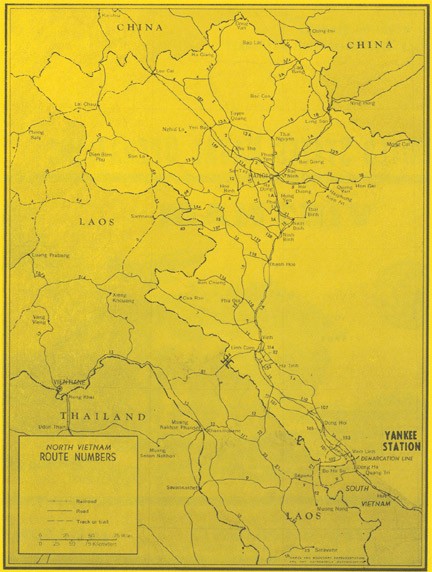
The tense situation in the Republic of Vietnam throughout May, highlighted by the burning of the USIS Library in Hue on 27 May, continued into June and erupted in the sacking and burning of the U.S. Consulate and Consul's residence in Hue by 500 to 800 Buddhist youths on 1 June. On 10 June the government sent two companies of Saigon combat police and an Airborne Battalion to Hue to establish order. By the 18th, the Government regained control and had arrested the leaders of the "Struggle Forces" or forced them to flee. Throughout the remainder of the month, Buddhist-led riots and demonstrations continued in Saigon, but were effectively contained.
Somewhat of a political landmark was reached on the 19th as the KY Government completed its first year in office, the first of the successor governments to do so since the overthrow of DIEM in November 1963.
In Air Operations, the month of June saw an increase in MIG engagements and enemy SAM firings, and heavy U.S. strikes against major North Vietnam POL storage areas. Of particular significance was one attack by RANGER aircraft against the Haiphong POL complex which was the country's largest storage area. All bombs were on target, and the damage was estimated at 80 per cent.
Results of Navy air-to-air engagements during June with 12 enemy planes were: 2 MIG-17s destroyed; 2 MIG-17s damaged; 1 NVN prop aircraft believed destroyed; and 1 NVN prop aircraft believed damaged or destroyed. One F-8E was lost by the Navy.
The increase of SAM firings during the last half of the month caused no Navy losses. Of the nine planes and nine aircrewmen lost to the enemy, however, eight were due to ground fire and one to a MIG, as cited above. At least two pilots were believed to have been captured.
A total of 5,793 attack sorties were flown. This marked an increase in numbers over North Vietnam, but fewer strikes in South Vietnam and Laos when compared to previous months.
During 18 to 27 June, the Amphibious Ready Group and its embarked Special Landing Force conducted Operation DECKHOUSE ONE in the II CTZ of South Vietnam. The SLF was later established ashore under the operational control of the 1st Cavalry Division and participated in Operation NATHAN HALE. Both operations were considered successful in terms of enemy casualties of over 500 KIA and more than 200 tons of captured rice.
Naval Gunfire Support continued its important and growing role by firing 32,877 rounds of all calibers -- an average of 1095 per day. This was more rounds fired than in any previous month and included destroyers, LSMRs, MARKET TIME ships and the veteran cruiser, ST. PAUL.
The versatility of the LSMR was demonstrated by CLARION RIVER (LSMR 409) and WHITE RIVER (LSMR 536), in providing fire support to troops ashore with a mixed bag of five-inch rockets and five-inch and 40MM projectiles. At one time CLARION RIVER fired at three targets simultaneously with excellent results. Altogether they participated in over 200 separate missions during the month.
Destroyers carried much of the load, however, and were consistently effective. THOMASON (DD 760), for example, demonstrated her' skill by walking her fire along a ridge line and down a trail into a VC village. The ridge was 600 feet high and the range 10,000 yards.
FLAG POLE critical supply items named by CINCPACFLT for June were the same as for May. They were:
F-l: Shortage of UH-1E aircraft for FMFPAC.
F-2: Shortage of 5" AAC/HC gun ammunition.
F-3: Lack of funds to.support aircraft overhaul and repair. (Closed on 15 June).
F-4: Shortage of survival radios.
SACRAMENTO (AOE 1), the fast combat support ship in WESTPAC since October, departed for home in June. Her Commanding Officer said on departure that her "high speed, vast capacity, multi-product, rapid delivery, vertical and alongside replenishment add up to a ... step forward ... for modern American sea power."
In all, 735 UNREPS were conducted during the month with 197 of them being at night. Also, there were 11 VERTREPS consisting of a transfer of more than 190 short tons.
This was another busy month for MARKET TIME forces, involving the boarding of nearly 9000 vessels, including another weapons-running trawler that was finally beached and destroyed. Of significance was its similarity to other trawlers (two destroyed; one tracked closely into CHICOM waters) engaged in bringing weapons and other supplies to the VC. This trawler had about 250 tons of cargo aboard, of which approximately 100 were salvageable. Weapons were predominantly of CHICOM origin. (See Appendix II).
Six PCFs arrived in June -- the 15th month of MARKET TIME -- bringing the total number of SWIFTs to 54. Two PACVs being evaluated were transferred to GAME WARDEN operations for a continuation of their assessment. A statistical summary of MARKET TIME activity is provided in Appendix III.
A study of the early stages of GAME WARDEN indicated the mission was being accomplished with VC units slowly being starved out of large areas of the RSSZ. In the Delta, forces were not at full strength, but reports from the IV CTZ indicated concern of the VC commanders over the presence of U.S. craft on the rivers, including the arrival of 16 new PBRs which brought that number to 63. See Appendix IV for a statistical summary that provides some comparisons with May.
Leadership within the VNN continued to improve. Exposure to USN units seemed to help, as did increased experience and the replacement of less-competent officers. The U.S. Navy advisory effort, of course, was the most important, with a good relationship existing between counterparts.
Coastal Groups participated in an increasing number of amphibious operations and blocking actions for U.S. and Vietnamese troops. Coastal Group 23 was singled out for special praise in DECKHOUSE ONE.
River Assault Groups were also effective. RAG 22, for example, at Nha Be, participated in nine search and destroy or reaction operations, which were effective in keeping the VC off balance.
The VNMC, in spite of heavy casualties in major engagements, was able to maintain the high spirit and morale which are traditionally "Marine." Despite unusually high losses among the officers, the junior officers and non-corns were in each case reported able to rise and "meet the challenge."
With the growth of the Navy commitment, more people became involved in PsyOps and Civic action programs. During June, six PsyOps trained officers took on duties in the four Coastal Zones and the two Riverine areas.
The effectiveness of Navy Civic Action is demonstrated by the words of one village chief who said that when the first PCFs arrived, there was apprehension in his village over the possibility of being mistreated. Since that time, however, his people have felt more secure than ever before.
For the fourth consecutive month the Marines participated in over 10,000 small unit counterguerrilla operations, and in addition, 11 large-scale offensive operations were conducted -- 9 by the III MAF, extending into four of the five provinces of I Corps, and two by Marines of the Special Landing Force of the SEVENTH Fleet. In all, 1,201 enemy were confirmed killed.
Marine fixed-wing aircraft flew more than 3,000 attack sorties and 38,000 helicopter sorties during the month.
In the FMFPAC summary of the month's highlights, it was stated that "The Free World effort is winning in I Corps, not just militarily, but in all the convergent battles which go to make up the war."
On the last day of the month, HANCOCK, RANGER and CONSTELLATION were at YANKEE Station and ORISKANY was at DIXIE. YORKTOWN was the CVS and PRINCETON the LPH. Total number of naval vessels in Southeast Asia waters -- offshore and in-country, South Vietnam -- was 200. This included 28 warships, 9 amphibious ships, 91 coastal patrol vessels, 64 river boats and 8 miscellaneous support craft.
Navy population on SEVENTH Fleet ships off Vietnam at this time was about 50,000, while almost 18,000 Navy and Coast Guard sailors and 54,000 Marines were based ashore.
July would usher in a period of increased air strikes against NVN POL storage areas and increased enemy infiltration to the south. Hanoi would still show no signs of wanting to negotiate, but against this escalating backdrop, the RVN would commence preparations for democratic elections in September.
During the first week of June, TF 77 carriers at YANKEE Station were RANGER, ENTERPRISE and HANCOCK. INTREPID was at DIXIE supporting search-and-destroy operations: LEXINGTON, HARDIWOOD, RENO, and MAKIKI. The tempo of operations was fast at the start. More than 650 sorties were flown over NVN the first week against various lines of communications, supply areas and railway targets. One pilot reported box cars exploding "like a string of firecrackers." Waterborne targets were fewer, however, apparently due to the pressure against them during April and May. The rest of the month was punctuated with MIG engagements, as well as attacks on POL sites around Haiphong that caused severe destruction of oil reserves and concomitantly increased the pressure against Hanoi.
A tabular break-down of attack sorties for March, April, May and June is as follows:
NVN |
SVN |
LAOS |
TOTAL |
|
| MARCH | 1923 |
3474 |
1247 |
6644 |
| APRIL | 2780 |
3184 |
917 |
6881 |
| MAY | 2568 |
2810 |
561 |
5939 |
| JUNE | 3078 |
2597 |
118 |
5793 |
On 21 June, four F-8Es from HANCOCK were challenged by four MIG-17s. One MIG was downed and another damaged in this engagement, with no losses to the Navy aircraft. The next night, two F-4Bs from RANGER engaged and destroyed at least one of two NVN prop planes detected by radar over water northeast of Thanh Hoa.
On 21 June, three HANCOCK F-8Es, after providing TARCAP for a strike on a highway bridge, joined their F-8E escort to search for a downed RF-8A. The pilot was located, but during the search one of the F-8Es was hit by ground-fire. Although a large section of the tail was shot away, the aircraft remained manageable and the pilot elected to remain on station. Shortly thereafter, however, he was detached due to low fuel state and headed for HANCOCK with an escort. Almost immediately, the two remaining F-8Es were attacked from above and out of the clouds by four MIG-17s. One F-8E engaged the first MIG section and was shot down. The other F-8E engaged the second section with a burst of 20MM cannon fire -- after which fuel was observed streaming from one of the MIGs. The F-8E pilot then fired a SIDEWINDER, but it failed to guide. The damaged F-8E and escort, which had been proceeding to base, turned back toward the action as soon as the MIG alert was broadcast. However, no MIGs were sighted on arrival at the scene and low fuel state required the two planes to turn for HANCOCK once more. Not long thereafter the pilot of the damaged F-8E noticed a MIG in pursuit.
Afterburner opened up the distance, and when the MIG broke off, the F-8E turned back once more and fired a SIDEWINDER, which guided perfectly and exploded at the tail of its quarry. When last seen, the MIG was trailing black smoke and spiraling off in a steep turn. In view of this, the action was evaluated as a confirmed kill. The damaged F-8E, down to 200 pounds of fuel, fortunately made a successful rendezvous with an A-4E tanker and returned to base after refueling.
Losses
During June, nine planes and nine pilots and crewmen were lost to the enemy. Four crewmen were rescued. Of the losses, one F-8E was due to a MIG, the rest to ground fire. One downed RANGER A-4 pilot was observed with North Vietnamese nearby, and another from HANCOCK reported over his survival radio that he was about to be captured.
Losses for June compared to other periods of the war follow:
MONTH |
AIRCRAFT |
AIRCREW |
AIRCREW |
| ALL 1964 | 4 |
2 |
2 |
| ALL 1965 | 101 |
80 |
46 |
| JAN 1966 | 6 |
5 |
5 |
| FEB | 9 |
10 |
2 |
| MAR | 11 |
11 |
3 |
| APR | 21 |
14 |
15 |
| MAY | 9 |
2 |
8 |
| JUN | 9 |
9 |
4 |
| TOTAL | 170 |
133 |
85 |
SAR
On 15 June, an F-4B aircraft from RANGER encountered intense AA fire in the vicinity of Haiphong which knocked out the port engine. Although the pilot was able to head the aircraft for the SAR DDs, COONTZ (DLG 9) and ROGERS (DD 876), the remaining engine flamed out as he approached them. The pilot rolled the starboard wing down to avoid hitting the destroyers, and both he and the RIO ejected. They landed safely and were picked up by an SH-3 SAR helo
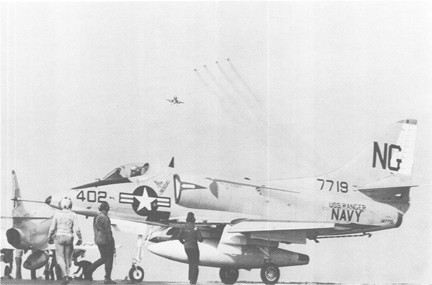
and delivered aboard COONTZ for medical check up. Found in good condition, they were returned to RANGER.
On 25 June, a CONSTELLATION A-6A was hit by flak during a bombing run on a target in NVN. The pilot was subsequently unable to control the aircraft and he and the RIO ejected over the Tonkin Gulf. An SH-3 helo arrived on the scene immediately and picked up the pilot, but the RIO was not in sight. Meanwhile, a RANGER A-4C pilot was forced to bailout due to flak damage received while attacking an automatic weapon position during rescue operations for the A-6 crew. The downed A-4C pilot landed in the water but came under heavy fire from the beach. The rescue helo, with the pilot of the A-6A still aboard, was diverted to this scene and managed to pick up the A-4 pilot uninjured, after which the helo returned once more to the supposed position of the A-6A RIO. However, further search results were negative, and both pilots were taken to the SAR ship, TUCKER (DD 875), from which they later returned to their respective carriers.
ENTERPRISE and BAINBRIDGE, the world's first nuclear surface vessels to see combat, had tentative visits to Japan cancelled because of political considerations there and departed for CONUS on 14 June. More than 100 of their combat aircrewmen were airlifted to TRAVIS from CLARK. The box scores for ENTERPRISE and KITTY HAWK, which also returned to CONUS in June, are as follows:
ENTERPRISE |
KITTY HAWK |
|
Norfolk: 10/26/65 |
Departed |
S. Diego: 10/19/65 |
130 days |
On Line |
121 days |
98 days |
YANKEE Station |
90 days |
32 days |
DIXIE Station |
31 days |
13,020 |
Combat or Combat Support Sorties |
10,604 |
8,966 |
Tons of Ordnance Delivered |
9,803 |
18,142 |
Total Arrested Landings |
12,222 |
Aircraft Lost |
||
16/4 |
Combat/Operational |
20/7 |
14/2 |
Combat / Operational |
20/2 |
177 |
Highest Number Combat |
148 |
|
No. Nautical Miles |
|
Alameda: 6/21/66 |
Returned |
S. Diego: 6/13/66 |
During the last week of the month, HANCOCK moved south to DIXIE Station and CONSTELLATION moved north to YANKEE. HANCOCK supported Operation DECKHOUSE ONE and other in-country ground operations, and RANGER aircraft successfully struck the Haiphong POL complex which processed about 70% of the total POL import.
When the month ended, HANCOCK, CONSTELLATION and RANGER all shared the line at YANKEE, and ORISKANY had arrived at DIXIE. YORKTOWN was the CVS and PRINCETON the LPH.
DECKHOUSE ONE
During 18 - 26 June, the Amphibious Ready Group (CTG 76.5) and its embarked Special Landing Force (CTG 79.5) of 1500 Marines participated in an amphibious operation near Song Cau in the II CTZ, 25 miles south of Qui Nhon. Forces involved were as follows:
CATF USS PRINCETON (LPH 5) |
CTG 76.5 |
SLF BLT 3/5 |
CTG 79.5 |
Naval Gunfire Support USS ST. PAUL (CA 73) |
CTG 70.8 |
|
|
|
|
As Marines swept up the beaches, guns and rockets from USS CLARION RIVER (LSMR 409) pounded suspected Viet Cong posts ashore, and at the same time PRINCETON launched helicopters carrying other Marines farther inland to block Communist troops trying to escape the Marines coming in from the sea.
"Huey" helicopters raked the back-of-the-beach area with machine-gun fire, while Navy strike aircraft poured in bombs. Some Viet Cong were seen scurrying away. At least three were reported killed by the bombing, and two others were captured.
Operations ashore proceeded smoothly, providing security to one flank of the Army's 1st Cavalry Division, seven miles to the south, in an operation nicknamed NATHAN HALE. Under these circumstances, COMUSMACV requested that DECKHOUSE ONE not terminate on 24 June as originally planned, but continue for an indefinite period pending further developments.
Since NATHAN HALE was not amphibious, the Special Landing Force, once established ashore, came under the operational control of the 1st Cavalry.
DECKHOUSE ONE, which terminated on 27 June, was considered a successful operation in all respects; NATHAN HALE terminated four days later. Final statistics of DECKHOUSE ONE/NATHAN HALE were as follows:
SLF casualties: 3 KIA and 21 WIA.
SLF killed 65 VC, captured 72, and apprehended 180 suspects.
SLF captured 211 tons of rice.
SWIFTs and PACVs
An additional six PCFs arrived in country during June, bringing the total to 54. All six units were
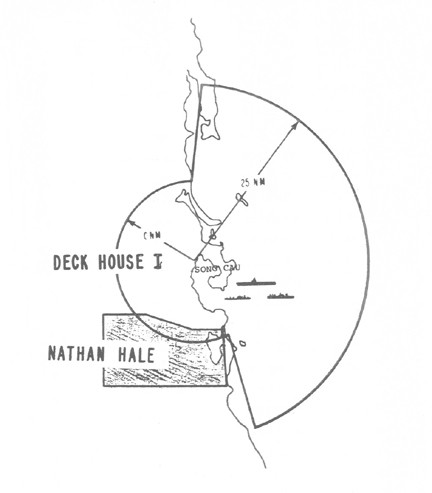
assigned to PCF Division 105 at Qui Nhon.
On 10 June, two PACVs moved to USS TORTUGA (LSD 26) for assessment during GAME WARDEN operations in the Mekong Delta. These operations included transits to and from the base at Cat Lo until 29 June, when the PACVs returned to Cat Lo to undergo modifications.
DELTA Patrol Group
The first test of the in-shore support ship concept in the Mekong Delta was initiated on 13 June. Intelligence indicated extensive VC movement of material in the mouths of the Co Chien and Bassac rivers to VC secret zones along the Delta Coast. In an attempt to counter this activity, COMNAVFORV directed CTF 116 to deploy mobile units to the vicinity of the mouths of Co Chien and Bassac rivers, and to establish anti-infiltration and interdiction patrols. This was accomplished by deploying River Section 512, with 10 PBRs, two PACVs, and one helicopter fire team aboard USS TORTUGA (LSD 26) for operations in the designated area.
During the remainder of the month TORTUGA, with her embarked components, maintained a mobile station in the vicinity of the river mouths. Although operations were at times curtailed by sea conditions, the PBRs maintained frequent patrols.
SEALS
A typica1 SEAL team ambush took place on 14 June. The ambush was set on the Co Gia River near the eastern edge of the Rung Sat Special Zone with the SEAL team moved into place by units of RAG 22. At 0030 on 15 June, a sampan was detected moving along the river and was taken under fire. One VC was killed, one wounded and a third escaped.
During June the Navy fired 32,877 rounds against VC targets in all Coastal Zones for an average of 1095 rounds per day. This was the highest number of rounds fired to date in any month:
| 8"/55 | 1 ,063 |
| 6"/47 | 6 |
| 5"/54 | 3,597 |
| 5"/38 | 16,848 |
| 5" SSR | 9,011 |
| 3"/50 | 1,116 |
| 81MM | 1,236 |
Eight NGFS ships were on station during the first four days of June providing gunfire support in the four corps areas. One of these ships, USS DAVIS (DD 937), responded to an emergency call for fire from friendly forces under attack on 3 June. Gunfire was so accurate that after firing only two rounds, the spotter reported that enemy weapons were silenced. DAVIS then moved 20 miles to the north to support a company of the SEVENTH Marines south of Chu Lai in the I Corps area. Under the direction of the I Corps NGLO, DAVIS pounded 13 targets during the remainder of the day, accounting for 61 VC structures destroyed and 78 damaged and burning. Meanwhile, in the II Corps area, CLARION RIVER blasted Viet Cong positions with 2214 five inch rockets, 63 rounds of 5"/38 projectiles and 2000 rounds of 40MM. The ship was operating in support of operation BINH PHU 7, a combined U.S. Army, Marine, Navy and ARVN search and destroy effort.
During the week of 5-11 June, ten destroyers and the cruiser ST. PAUL were active in NGFS missions. This was the first engagement in the Vietnam conflict for the veteran cruiser, a former SEVENTH Fleet Flagship. Her nine 8"/55 guns spent a busy week pounding VC gun positions, troop concentrations, tunnels, bunkers and structures. The ship's secondary battery of 5"/38 guns provided night illumination as well as destructive fire on the smaller targets.
On 11 June, JOHN W. THOMASON sailed into Vung Xuan Dai to take a fortified VC village under fire. Due to the proximity of the ship to the target, coordinated direct and indirect fire was delivered in the area. As a result, four junks were sunk and 39 structures were destroyed or damaged. The combined effect of high explosive and white phosphorous projectiles was devastating. Several large fires resulted, sending columns of smoke billowing into the sky. Outstanding results were reported by the II Corps spotter. The following week, 12-18 June, THOMASON again blasted the VC. On 12 June, while enroute to firing position for a scheduled mission, the ship's spotter received confirmed intelligence from a VC deserter that two VC squads were located on a nearby ridge line. The information was passed to an airborne spotter in the area. The airborne spotter "walked" THOMASON's fire along the ridge line and down a trail leading into a VC village. The spotter reported outstanding effect by all rounds and was impressed with THOMASON's ability to move the impact point along the ridge line 600 feet high at a range of 10,000 yards. Later, the spotter directed THOMASON's fire against a fortified village complex. A total of 65 structures were destroyed or damaged and 25 fishing boats demolished. Four large secondary explosions were observed. More than 150 targets were taken under fire during the week by the destroyers THOMASON, R. B. ANDERSON, MORTON, TAUSSIG, JOHN A. BOLE, FISKE, HOPEWELL, CHEVALIER, the cruiser ST. PAUL and the rocket ships WHITE RIVER and CLARION RIVER.
There was no letup in action the following week, 19-25 June, as a dozen Naval Gunfire ships were active providing support around the clock. Many of the missions fired were at night in support of DECKHOUSE ONE. One particular mission involved a team effort between the Marine ground
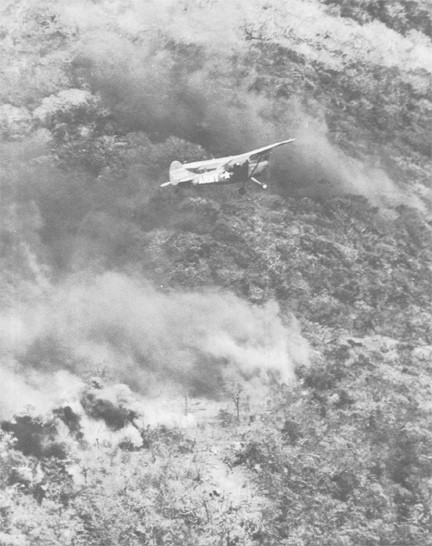
spotter, the destroyer JOHN W. THOMASON and the LSMR, CLARION RIVER. The spotter directed white phosphorous projectile fire from THOMASON into a foliaged area in order to drive VC troops into the open. As soon as the VC were flushed into the open area, it was saturated with concentrated rocket fire from CLARION RIVER's launchers. All the VC were believed killed.
For the last five days of the month, the emphasis on NGFS was placed in the I and II Corps areas where search and destroy operations OAKLAND and NATHAN HALE were in progress. OAKLAND, a combined SEVENTH U.S. Marine/SEVENTH ARVN Rangers sweep and clear operation, was supported by DAVIS and WHITE RIVER. Operation NATHAN HALE utilized the guns of the cruiser ST. PAUL and destroyer BASILONE.
Service Force Operations
The fast combat support ship, SACRAMENTO (AOE 1), deployed in WESTPAC since October 1965, departed YANKEE Station on 6 June for the last time. She was scheduled to arrive CONUS on 12 July. Her nine month cruise provided the following statistics:
| Ships replenished | 789 |
| Provisions | 2318 ST |
| Ammo | 14387 ST |
| NSFO | 1178 MB |
| JP-5 | 548 MB |
| AVGAS | 43 MB |
| 142915 LBS | |
| Passengers | 1338 |
| Vertical Rep | 5020 ST |
| Miles steamed | 60409 |
| Transfer Rate . |
Up to 260 S/T/HR. (Along-side) |
SACRAMENTO's Commanding Officer, Captain H. E. SHEER, USN, stated on departure from YANKEE that "high speed, vast capacity, multi-product, rapid delivery, vertical and alongside replenishment add up to a significant step forward in mobile logistic support for modern American sea power."
The one thousandth helo landing was made aboard the hospital ship REPOSE on 2 June. From 31 January 1966, when she arrived off Danang to that date, REPOSE received 373 litter patients and 1021 ambulatory patients for treatment.
USS TUTUILLA (ARG 4) chopped to COMSEVENTHFLT 29 June and was scheduled to provide internal combustion engine repair for COMNAVFORV's patrol craft and boats.
In all, 735 UNREPS were conducted during the month of June with 197 of them being at night as follows:
| AO/AOE -- | 121 |
| AE/AOE -- | 19 |
| AF/AFS -- | 35 |
| AKS -- | 22 |
| 197 |
Also, 11 VERTREPS were conducted, consisting of 196 lifts for a transfer total of 193.9 short tons.
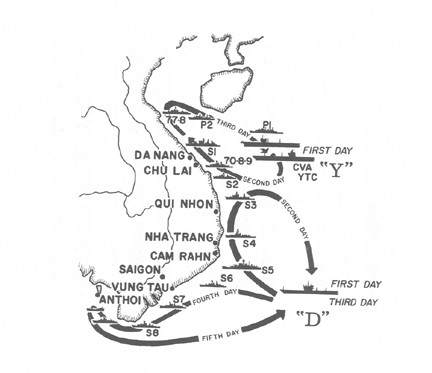
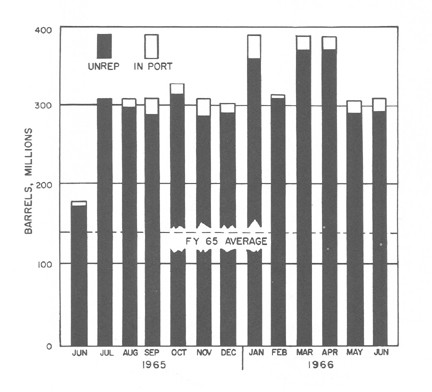
Comparative underway replenishment information for June is tabulated as follows:
AVERAGE |
TRANSFER |
TOTAL |
TOTAL |
DAYS |
|
||
| SHIP (AO) | CV | CA |
DD |
RPL | TRF | WESTPAC |
RFS |
| CIMARRON (22) | 5265 | 2777 |
2083 |
20 | 37,178 | 89 | 80.9 |
| PLATTE (24) | 5675 | 4587 |
3497 |
35 | 76,887 | 130 | 80.8 |
| CHEMUNG (30) | 4638 | 3480 |
2889 |
29 | 59,704 | 200 | 73.0 |
| GUADALUPE (32) | 5363 | 4230 |
3484 |
80 | 218,293 | 156 | 85.9 |
| CACAPON (52) | 4590 | 4670 |
3130 |
94 | 306,379 | 118 | 87.3 |
| CHIPOLA (63) | 5710 | -- |
3260 |
70 | 86,643 | 200 | 83.5 |
| TOLOVANA (64) | 5489 | -- |
3842 |
11 | 24,239 | 30 | 80.0 |
| HASSAYAMPA (145) | 4386 | 6861 |
4332 |
25 | 38,349 | 18 | 72.2 |
| KAWISHIWI (146) | 7668 | 5525 |
3727 |
47 | 117,845 | 206 | 83.0 |
| SACRAMENTO (AOE 1) | 7623 | 4788 |
3569 |
41 | 68,037 | 252 | 84.1 |
AE |
|||||||
| MT BAKER | 59.5 | -- |
23.3 |
12 | 845.6 | 160 | 75.0 |
| MAZAMA | 71.8 | 24.0 |
24.9 |
13 | 1069.3 | 65 | 78.5 |
| VESUVIUS | 82.9 | -- |
31.1 |
15 | 1695.7 | 35 | 80.0 |
| PYRO | 149.6 | 31.7 |
23.2 |
29 | 1875.5 | 117 | 77.8 |
| HALEAKALA | 99.9 | -- |
32.9 |
33 | 1273.9 | 184 | 82.1 |
AOE |
|||||||
| SACRAMENTO | 53.7 | 24.7 | 8.1 |
35 | 619.4 | 252 | 84.1 |
AF |
|||||||
| GRAFFIAS | 114.1 | -- |
21.3 |
34 | 586.0 | 35 | 71.4 |
| PICTOR | 51.7 | -- |
23.7 |
17 | 92.1 | 90 | 84.4 |
| BELLATRIX | 95.0 | 54.1 |
29.4 |
55 | 999.3 | 63 | 82.5 |
AKS |
|||||||
| POLLUX | 44.9 | 15.4 |
21.2 |
45 | 290.4 | 365 | |
Air Munitions
Since April 1966, CINCPAC has exercised control over all air munitians in the Pacific. Available air munitions, both from existing Air Force and Navy stocks and from future production, are allocated to each service on a monthly basis. This allocation frequently requires inter-service transfers.
Navy and Marine ammunition expenditures in June were as follows:
| ITEM | NAVY | MARINE |
MK 81 |
9765 |
4298 |
MK 82 |
4125 |
3203 |
MK 83 |
2294 |
1291 |
MK 84 |
100 |
0 |
ANM 57 |
283 |
30 |
ANM 81/88 |
3735 |
1683 |
ANM 64 |
770 |
0 |
ANM 65 |
292 |
8 |
ANM 66 |
98 |
315 |
FIREBOMB |
938 |
793 |
5" ZUNI |
4895 |
1000 |
2.75" RKT POD |
1334 |
158 |
PARA FLARES |
1603 |
26 |
CBU-2 |
0 |
0 |
20MM MK 12 |
118,005 |
98,634 |
BULLPUP A |
286 |
55 |
BULLPUP B |
203 |
0 |
SHRIKE |
35 |
0 |
ANM 59 |
36 |
0 |
20MM M3 |
103,537 |
0 |
7.62 MM |
0 |
0 |
Flag Pole
CINCPACFLT Flag Pole critical supply items for June remained the same as in May; i.e.:
| F-1: | Shortage of UH-IE aircraft for FMFPAC. |
| F-2: | Shortage of 5" AAC/HC gun ammunition. |
| F-3: | Lack of funds to support aircraft overhaul and repair. (Closed on 15 June) |
| F-4: | Shortage of survival radios. |
Naval Support Activity Saigon
The activities of the U.S. Naval Support Activity, Saigon and its detachments increased in scope and intensity during June as construction of new support bases continued. Progress at the detachments varied considerably depending on local conditions. Problems encountered in base construction were numerous and varied. Typically, they included such items as negotiating for real estate; making local arrangements for joint U.S./Vietnamese utilization of interim facilities; constructing work shops, piers, and living quarters; stocking supplies and repair parts; organizing base defense; and repairing the boats. As the basic housekeeping needs of the bases became established, more attention was directed toward such support items as engine and electronic repair.
Under the auspices of the Public Works Department, work was started on the construction of interim GAME WARDEN base facilities at Sa Dec, Vinh Long, and Long Xuyen. All bases were to be ready to receive operational units in July. Work continued on the base at Nha Be, with drilling started on a water well.
In other construction work the renovation of spaces at NAVFORV headquarters progressed on schedule, and a contract was let for the leveling of the MARKET TIME P2V parking apron at Tan Son Nhut Airbase at Saigon. Daily rains, however, prevented any work by the contractor. This situation was expected to continue until September. Similar conditions delayed work on the NAVSUPPACT Air Division parking area.
Repair capabilities continued to improve as shops and personnel became available. The shop at the Cat Lo Support Facility was in full operation as of 30 June. At the NAVSUPPACT Detachment at Cam Ranh Bay, repair facilities were completed and equipment partially installed.
Additional steps toward achieving full operational capability were taken during the month. One YFR, eight LCMs and USS BLUEBIRD (formerly MSC 121) were assigned to NAVSYPPACT. This sea lift will resupply MARKET TIME and GAME WARDEN bases throughout the II, III and IV Corps Tactical Zones.
Personnel strength of the NAVSUPPACT Detachments increased rapidly during June, with the on-board percentage of allowance at about 75% for officer and 60% for enlisted by the end of the month. However, a serious shortage continued in the technical ratings.
POINT LEAGUE Trawler Incident
The Ca Mau Peninsula, southern-most region of Vietnam, was the scene of two known infiltration attempts in the five month period from December 1965 to May 1966. On 19 June at 1545, an SP-2H from VP-2 on a special barrier MARKET TIME flight, detected and photographed another trawler at a position eighty miles east of the Con Son Islands on a SSW course at a speed of ten knots. At 0300 the next morning, USCGC POINT LEAGUE, patrolling off the mouth of the Co Chien River, obtained a radar contact at a distance of 7.8 miles. The contact, heading toward the mouth of the river appeared to be a steel hull and was later identified as the same trawler reported by the SP-2H. There was no response to challenge, and a running battle ensued with the trawler going hard aground approximately 100 yards from the beach.
A helicopter fire team from Can Tho, and a MARKET TIME VP-2 aircraft were the first on the scene to assist. Others were USCGC POINT SLOCUM, HAVERFIELD (DER 393), who assumed on-scene commander, JOHN A BOLE (DD 795), USCGC POINT HUDSON and river and coastal units of the VNN. The Air Force also provided two F-100s to suppress some weapons fire from the beach.
About 1000, a volunteer group from the WPBs, HAVERFIELD and the VNN units boarded the trawler, put out the fires that had resulted and started to unload the 250 tons of cargo, of which about 100 tons were salvageable.
The weapons were predominately of Chinese Communist origin, with some from the Soviet Union and a small number of North Korean rifles. The latter were the first North Korean manufactured arms found in the IV CTZ. Some ammunition boxes were dated 1966, indicating a relatively rapid Chinese Communist distribution system. A new type of 75MM spin-stabilized projectile recovered was believed compatible with CHICOM smooth-bore weapons and would have increased the Viet Cong anti-tank and anti-patrol boat capability. Instructions for weapon use were all written in Chinese. (See Appendix II).
The trawler was 98 feet 11 inches long with a beam of 19 feet 4 inches, an estimated full load draft of 6 feet 7 inches and a displacement of 280 tons. The steel hull was green in color with an ivory superstructure and had two cargo holds. The only hull identification was the number 2135 on the bow. As in the case of the trawlers intercepted on 31 December 1965 and 10 May 1966, the numbers were on scoreboard-type removable plates with numbers on each side. The basic hull configuration was similar to the HISSEM discovered trawler of 31 December, the POINT GREY-trawler of 10 May, and the weapons-runner sunk in Vung Ro Bay in February 1965. The major difference was that the superstructure was situated further aft. The known armament consisted of single .50 caliber machine gun mounts aft of the pilot house, on the forecastle and amidships on both sides. These guns were covered by fishing nets when the trawler was first sighted. For
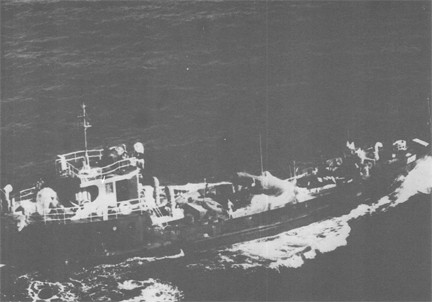
additional camouflage, the trawler carried fishing buoys and buoy marking poles in the waist.
The engine room was in excellent condition and the engineering equipment in a good state of repair with an ample supply of spare parts. The main engine was an East German, 225 HP four cycle, solid injection and air-starting diesel. It had been running steadily since 14 June.
Although the actual complement of the crew is not known, berthing for fourteen was found. The initial photograph showed a total of eleven persons visible. Following the action of 20 June, five bodies were discovered behind the beach, and one body was found in the engineroom. Two wounded crewmen were captured by ARVN troops on shore, one of whom subsequently died. The other underwent interrogation but revealed no information.
Although some documents were destroyed in the fire or otherwise lost, several were recovered from the trawler and the dead crewmen. Entries in the navigator's workbook and on charts, suggested a track that commenced on 15 June about 100 N.M. southwest of Hong Kong -- the same area of entry the suspicious trawler in December used while being tracked. Study of the track indicated probable use of latitude sailing once in the area of the Con Son Islands, probably with the intention of using them as a land fall.
A captured chart suggested that the intended destination was possibly the Lang Nuoc River mouth in Vinh Binh province. An alternate course was also plotted to the mouth of the Con Chung River. A review of the known and suspected infiltration attempts by steel-hulled trawlers so far, revealed that all were planned for high tide and first light. Lunar high tides average ten to twelve feet.
Patrol Activities
The steady increase in the number of MARKET TIME units in-country and on patrol gave rise to a marked increase in incidents during June. Most of these incidents involved patrol units taking evading junks under fire after all efforts to bring the suspect junks alongside, including use of the siren, bullhorn and warning shots, had failed.
Almost all the evading junk incidents occurred in the First and Second Coastal Zones, with a suspected contact typically running close to the beach and evading as soon as the first warnings were signalled. Often the occupants managed to flee to safety on the beach or jump overboard when the first shots were fired. In all instances the junks were either sunk, destroyed or damaged. (See Appendix III) .
Gunfire Support
MARKET TIME units conducted pre-planned gunfire
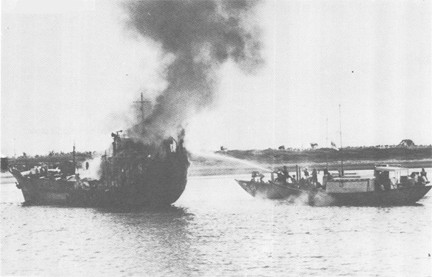
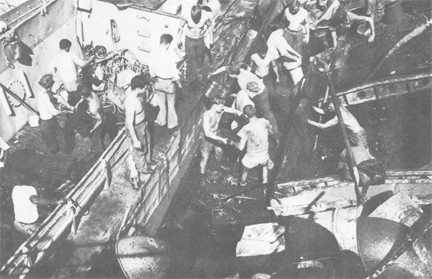
support missions during June and responded to seven requests for emergency gunfire support during the month. Most missions were fired at Viet Cong installations or troop concentrations. On 8 June, USCGC POINT GARNET and PCF 5 responded to a call for assistance from a Special Forces outpost under attack on Phu Quoc Island. Forty rounds of 81MM mortar ammunition were fired while assisting the outpost.
Emergency Action Plans
There are three emergency action plans for MARKET TIME units to establish barriers or concentrated area inspections of junks and sampans to thwart the movement of contraband. They are designed to be rapidly executed with minimum communications.
Plan LINE PLUNGE establishes a barrier perpendicular to the shoreline to intercept traffic moving along the coast. Plan END AROUND establishes a barrier parallel to the coastline for intercepting suspect traffic moving from seaward toward the shore, or from the shore to the sea. Plan CORRAL is set to establish a specific area of search where it is indicated that closer scrutiny of traffic, such as a large concentration of junks is required.
Plan CORRAL was executed twice during June, on both occasions in the Vung Tau area. Although nothing suspicious was detected, response was excellent in both instances. Plan END AROUND was executed once.
Search and Rescue Operations
MARKET TIME units participated in four search and rescue operations during June. On 6 June, USS FORTIFY (MSO 446), USS DYNAMIC (MSO 432), PCF 45 and PCF 51 conducted SAR operations following a collision between two Vietnamese civilian junks off Ban Than Point just north of Nha Trang. Five survivors were recovered. On 17 June, FORTIFY and PCF 48 conducted SAR operations at the scene ofa Navy C-130 crash north of Cam Ranh Bay. No survivors were found. On 27 June, PCFs and LCPLs from MIUWS 12 conducted an unsuccessful search for a man lost overboard from USS CHESTERFIELD COUNTY.
At 1800 on 27 June, two junks from VNN Coastal Group 36 departed USS TORTUGA for their base at the entrance to the Bassac River. At a point approximately fifteen miles from the entrance to the Bassac River, one junk developed engine trouble and the second, with two U.S. advisors and six VNN sailors embarked, came alongside to assist. While alongside, the hull opened up on the assisting junk, and it started taking on water rapidly. Weapons and other equipment were quickly transferred to the junk with engine trouble, but in the confusion it drifted away. All efforts to save the swamping junk failed. At 1900 the eight occupants were forced to take to the water, tying themselves together and using five life jackets and several crates to stay afloat. TORTUGA, which had maintained radio contact with the CG 36 advisors, immediately dispatched SAR units including an LCPL, LCVP, PACV, and fire team helos. MARKET TIME units sent, included USS INFLICT (MSO 456), PCF 40, USCGC POINT LEAGUE and USCGC POINT HUDSON. A flare aircraft was also dispatched to assist. A creeping line search plan was executed throughout the night in spite of 25 to 40 knot winds and four to six foot swells. The disabled junk with engine trouble was recovered at 1940 by an LCVP from TORTUGA with seven survivors embarked. They reported that the eight men from the swamped junk were still in the water. The search continued until the following morning at 0700 when POINT LEAGUE recovered the eight survivors in excellent condition.
MARKET TIME Forces
Six additional PCFs arrived in-country during June, bringing the total to 54. All six units were assigned to PCF Division 105 at Qui Nhon.
Mobile Inshore Undersea Warfare Surveillance Unit ELEVEN (MIUWS 11) became operational at Cam Ranh Bay during June, bringing to two the number of operational MIUWS units.
In MARKET TIME air operations USS SALISBURY SOUND (AV 13) disestablished the seadrome at Cam Ranh Bay on 3 June. Patrol Squadron TWO with a detachment of seven aircraft at Tan Son Nhut Airbase at Saigon continued daily surveillance flights in support of MARKET TIME operations. Patrol Squadrons EIGHT, TWENTY-EIGHT and FORTY-SEVEN flying P3A aircraft out of Sangley Point, supported MARKET TIME operations in the northern area from Cam Ranh Bay to the Seventeenth Parallel.
In addition, the following SEVENTH Fleet units operated as a part of Task Force 115 during all or part of June:
USS SAVAGE (DER 386) |
USS BRISTER (DER 327) |
USS VANCE (DER 387) |
USS FALGOUT (DER 324) |
USS FORSTER (DER 334) |
USS KOINER (DER 331) |
USS HAVERFIELD (DER 393) |
USS KRETCHMER (DER 329) |
USS WARBLER (MSC 206) |
USS ALBATROSS (MSC 289) |
USS DYNAMIC (MSO 432) |
USS CONFLICT (MSO 426) |
USS FORTIFY (MSO 446) |
USS ENGAGE (MSO 443) |
USS IMPERVIOUS (MSO 449) |
USS INFLICT (MSO 456) |
USS LOYALTY (MSO 457) |
USS WIDGEON (MSC 208) |
The arrival of sixteen new PBRs (total - 63) and the movement of two additional River Patrol Sections into the Mekong Delta highlighted GAME WARDEN operations during June. In the Rung Sat Special Zone PBRs assumed the remaining stations occupied by PCFs, releasing them for MARKET TIME. An assessment of the early stages of GAME WARDEN indicated the operation was accomplishing its mission of interdicting VC movements on the major rivers of the Rung Sat Special Zone (RSSZ), and on that portion of the Bassac River in the vicinity of Can Tho where the initial Delta Patrols were being conducted. (See Appendix IV).
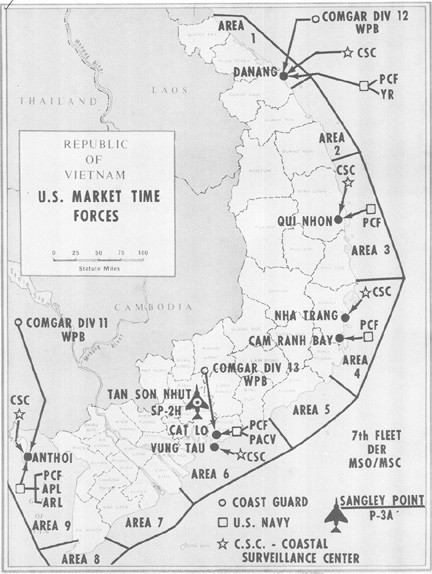
The heaviest action involving PBRs occurred the morning of 20 June at the mouth of the Bassac River near the small Cai Co River. PBRs 57 and 58 detected, then closed and illuminated a forty foot junk crossing the Bassac estuary at high tide. At a range of fifty yards the junk opened fire at PBR 57, the lead boat, using automatic weapons and an anti-tank rocket launcher. The initial round from the rocket launcher found its mark on the PBR, but heavy .50 caliber and .30 caliber machine gun fire forced the junk to flee up the shallow Cai Co River. Of the estimated ten Viet Cong on board, at least two were killed or wounded. One was seen to fall overboard and the other fell back into the boat. The PBRs suffered two casualties; one the forward gunner and the second a Vietnamese Navy liaison petty officer from Coastal Group 35. Both were evacuated by helicopter with shrapnel wounds. PBR 57 received a twelve inch by eight inch hole on the forward deck and a five inch hole on the starboard side above the waterline. The .50 caliber machine gun-mount housing shield, the whip antenna, the radar antenna and the spotlight lens were damaged by shrapnel.
On two occasions armed helicopter fire teams from TORTUGA saw significant action on the Bassac River. On 19 June the helicopters fired on three camouflaged sampans near the mouth of the river in the same area as the PBR 57/58 incident. Automatic weapons fire was received in return. One Viet Cong was killed, one sampan destroyed and two sampans damaged. One man from the fire team was wounded when a round struck the flexible gun drive. On 21 June the fire team again came under automatic weapons attack. The fire was returned with machine gun and rocket fire. One hut was destroyed and an estimated five Viet Cong killed.
A sandbar fourteen miles southeast of Can Tho in the Bassac River provided the location for significant Viet Cong psychological warfare activity on 27 June. Here, at 2230, PBR 38 discovered a beached bamboo float. The float was a replica of a PBR, covered with haze-grey canvas and flying a Viet Cong flag. A sign on board - in Vietnamese - challenged the Americans to fight, and included the phrase "Sat My" - "Kill Americans." The float was taken under fire by .50 caliber machine guns, damaged and forced into the river. Cautious of possible booby traps, the PBR stayed well clear and allowed it to float away with the current.
Rung Sat Special Zone Patrol Group
Early in June, reliable intelligence sources indicated that U.S. river patrol units, fixed wing air strikes, armed helicopter reconnaissance missions and PCF mortar harassing fire along the east bank of the Soirap River north of the Vam Sat River had forced the Viet Cong to abandon this crossing point. Other sources indicated that patrols on both the Long Tau and the Soirap Rivers had effectively curtailed Viet Cong night-time movements. Instead, crossings were being made around sunrise and sunset, using seemingly innooent sampans stationed in mid-stream at bends in the river to notify Viet Cong sampans of the passing of patrol units. To counter this, special daytime patrols were established by PBRs on 8 June.
The helicopter fire teams continued their effective reconnaissance of the Rung Sat Special Zone, and on several occasions came to the assistance of beleaguered outposts. In the most significant incident, on the night of 9 June, U.S. Army advisors reported that the hamlet of Binh Thanh was under attack by an undetermined number of Viet Cong, and the fire team from TORTUGA was launched to the scene while PBRs on station stood by to assist. The helicopters made strikes to the south and east of the hamlet, suppressed the fire and thwarted the attack.
The problem of civilian movement in prohibited areas was again brought to light during June. On 2 June, three sampans were taken under fire by an armed helicopter on patrol of the Long Tau River. The following day Vietnamese personnel found one dead and two wounded in the vicinity of the strikes. The two survivors, reported to be civilians, stated they had been fired on from a helicopter. Medical evacuation of the survivors was made.
One successful SEAL team ambush took place during the month. On 14 June, an ambush was set on the Co Gia River near the eastern edge of the Rung Sat Special Zone, with the SEAL team moved into place by units of RAG 22. At 0030 on 15 June, a sampan was detected moving along the river and was taken under fire. One Viet Cong was killed, one wounded and a third escaped.
In mine countermeasures activity, Nha Be based MSBs continued their daily sweeps of the Long Tau River ship channel and the Nha Be anchorage. They were assisted by VNN MLMSs. PBRs from Nha Be continued to assist U.S. Army patrol units in providing security at the Nha Be anchorage. In a significant mine discovery during the afternoon of 12 June, a friendly fisherman located one electrical wire leading from the bank down into the Long Tau Rjver approximately five miles southeast of Nha Be. He reported the discovery to Nha Be, and RAG units were dispatched to the scene. About five meters from the bank two poles, three yards apart, were found protruding about 18 inches above the surface. At the bottom of the poles a mine was found, made from two oil cans fastened together by two wooden sticks. It was capable of remaining beneath the surface in wet storage, then being moved into any location in the channel by a sampan after the passage of the minesweepers.
The PBRs continued to experience extensive surface corrosion. Especially susceptible were the Jacuzzi pump
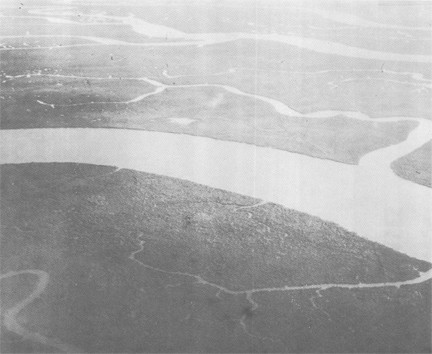
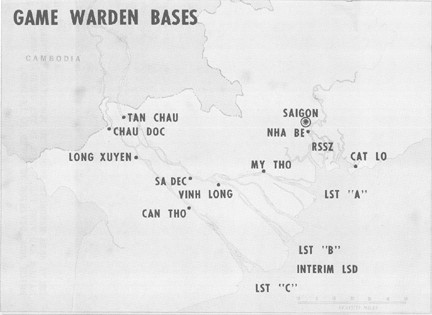
grill inserts. Shaft casualties also continued to be a problem. New type, stronger shafts that were on order had not been received by the end of the month. During June, RIVRONFIVE commenced issuing Squadron Maintenance Bulletins covering maintenance problems encountered in the PBRs. These were sent to all River Divisions, River Patrol Sections, and Naval Support Activity, Saigon detachments that support PBRs.
Initial GAME WARDEN Assessment
Indications were that the Viet Cong were slowly being starved out of large areas of the RSSZ, a region traditionally under enemy control. The employment of ground forces to strike at the heart of the RSSZ - Operations JACKSTAY, LEXINGTON III, and continuing VNN and Regional Force operations -- destroyed large quantities of food, arms and ammunition, and numerous Viet Cong facilities. Continuous GAME WARDEN patrols in support of these operations contributed to the disruption of resupply routes, and a marked reduction in the number and scope of VC initiated incidents was indicative of the enemy's loss of freedom of action. LSD/LST based UH-IB fire teams were effectively employed for direct PBR support, and for armed reconnaissance and preplanned strikes.
Although GAME WARDEN forces in the Delta were not yet at full strength, initial experience with the one section operating from the temporary base at Can Tho was noteworthy. On two known occasions attempted crossings by Viet Cong units were stopped by patrols. Reports from the IV Corps Tactical Zone indicated that VC commanders voiced concern at the presence of the U.S. craft on the river. Disruption of VC tax collectors on the Bassac River was confirmed by the Tre On Village Chief, who stated that the arrival of the PBRs enabled villagers for the first time to transport their produce to Can Tho without paying taxes. The VNN commander of the Fourth Riverine Area considered friendly river traffic of the Bassac to be markedly increased. In addition, the influence of PBR night patrols resulted in increased RAG 25 patrol activity during the daytime.
Based on this initial assessment, GAME WARDEN was considered to be an important deterrent to Viet Cong movements on and across the major rivers of the Delta and the Rung Sat Special Zone. Increased effectiveness was anticipated as additional boats and bases become operational and the crews develop tactics to counter Viet Cong efforts.
Leadership within the Vietnamese Navy continued to improve with greater exposure to USN units, increased experience and the replacement of less-competent officers. Counterpart relations in general were regarded as satisfactory, particularly among the more junior officers. One problem area was the possibility that the increasing USN presence in Vietnam might begin to overawe the Vietnamese. Advisors were aware of this problem, however, and were doing what they could to alleviate it.
Maintenance of VNN units continued to be troublesome. There was a lack of trained personnel, old ships and equipment, poor personnel distri« bution, a backlog of work at the Naval Shipyard, and an occasional shortage of repair parts. Repairs to ships at times were of poor quality, and Coastal Zone advisors reported that ships on patrol had frequent equipment failures.
During June there was a large increase in the number of amphibious operations and raids conducted by the Coastal Groups, which also participated in numerous blocking actions for U.S. and Vietnamese land operations.
Coastal Group 23 and its advisors received praise for their support of Operation DECKHOUSE ONE, conducted from 17 to 27 June by the SEVENTH Fleet Amphibious Ready Group. CG 23 junks landed UDT personnel for pre H-hour beach reconnaissance; then for the remainder of the operation maintained at least three boats on station in antiexfiltration patrols. In addition, advisors and VNN personnel from CG 23 served as interpreters and provided guidance on the characteristics of the operation area.
In the Third Coastal Zone, a Coastal Group 33 patrol captured a sampan powered by a U.S. manufactured AID engine. When tested, it was found to be "very fast."
One ROUND-UP operation was conducted in the Fourth Naval Zone in the Mui Nai - Pirate Islands - Ha Tien area from 8 to 9 June. Units from Coastal Groups 42 and 43, and PGM 614 were involved and checked 120 junks and 353 people. Civic action materials were also distributed.
Units attached to River Assault Groups in the Third Riverine Area were effectively used during June. RAG 22 at Nha Be was the most active and the most effective, participating in nine operations. Early in June it made a significant contribution to Operation LEXINGTON III in the Rung Sat Special Zone, and the remainder of its activity served to keep the Viet Cong off balance, both in search and destroy and reaction operations.
The continuing productivity of small scale River Assault Group operations is illustrated by a post-action report from the advisor of RAG 23 at Ving Long. On 15 June RAD 23
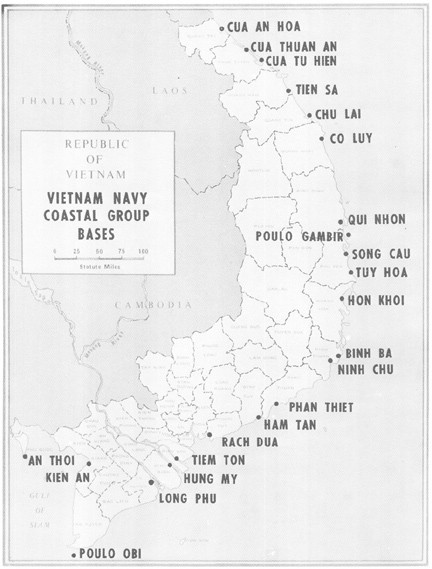
embarked 80 Popular Force troops in 10 boats and proceeded to Lao Giai Island in the middle reach of the Co Chien River, where 100 Viet Cong were concentrated. Although the main body of Viet Cong managed to escape across the river to Kien Hoa province, sixteen suspects were detained, several of whom were positively identified as Viet Cong. The advisor reported the people of the island were quick to point out Viet Cong sympathizers, stating that they were tired of the ever-increasing VC taxes.
In June the Vietnamese Marine Corps was heavily engaged with Viet Cong forces on a number of occasions. For example, Task Force Bravo, activated on 11 June and consisting of the First and Second VNMC Battalions, was airlifted to Hue as a civil disorder force on 17 June. A few days later its mission was changed and the force participated in Operation LAM SON 283 in Quang Tri Province, a three day search and destroy operation under the control of the ARVN First Infantry Division. As a result of Marine action, 173 Viet Cong were killed and 23 confirmed VC and 38 suspects captured. Also seized were 27 individual weapons and five crew-served weapons. VNMC losses were 32 killed and 45 wounded.
On 29 June the Second Battalion was ambushed by the 802nd VC Battalion (reinforced) while on a motorized convoy on Route One about 25 kilometers northeast of Hue. The Battalion was enroute to participate in an operation with units of the ARVN First Division north of Quang Tri city. In the ambush 42 Vietnamese Marines were killed, 96 were wounded and 35 weapons were lost. Fifty Viet Cong were killed, and a follow-up counterattack by ARVN and U.S. Marine Corps units, 161 VC were killed. The Battalion then returned to Hue for the remainder of the month.
During the month the Vietnamese Marine Corps had a heavy number of casualties. This did not affect its morale or fighting capabilities. On the contrary, it revealed a tenacity and devotion to duty of the individual Marine which was extremely heartening. Heavy casualties among the officers necessitated assumption of authority by junior officers and non-commissioned officers on several occasions. In each case the junior officers and NCOs were found to be fully capable of meeting the challenge.
On the military front, COMUSMACV confirmed two new North Vietnamese regiments in South Vietnam, bringing the total confirmed North Vietnamese strength in country to 32,810. Total enemy strength in SVN at the end of June, including Viet Cong units, stood at 90,155 with an additional 9,300 men carried in the probable and possible categories.
In spite of MARKET TIME success in curtailing external sea infiltration, the Communists still enjoyed relatively
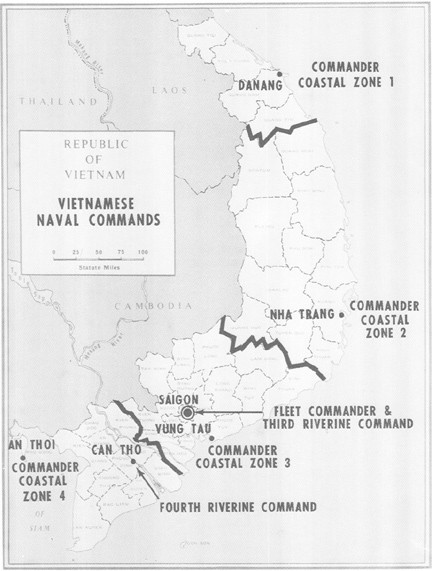
free use of the inland waterways for resupply of their forces. Especially in the delta region, the Viet Cong used waterways to provide inter-corps and inter-provincial contacts.
The number of SAM sites in North Vietnam increased by four to 113. Of interest was site 111, first revealed fully occupied in photography of 8 June, which was located in the Than Roa Barracks area. This marked the first time that photography has revealed a SAM site in a barracks area. The site was apparently vacated on 9 June, however, as 10 June photography failed to reveal any SA-2 equipment there.
The North Vietnamese use of SAMs came under attack this month by the Soviets. The USSR was reportedly irritated by the mediocre results, pointing out that no planes had been destroyed by SAMs in several weeks. Soviet instructors were withdrawn several months ago at the request of the Vietnamese, who claimed to have the necessary specialists. Moscow, however, felt that the instructor personnel were removed at the suggestion of Communist China, leaving the Soviets in the position of arms suppliers without any control or influence over their use.
Also related to SAM deployment was the achievement of operational status of two MI-6 Rook helicopters which were delivered by the Soviet ship Sovetsk in March. With a load capacity of 13,000 to 26,000 pounds, these heavy helos could be used to ferry incoming SAM equipment to nearby support facilities for assembly and check out before delivery to operational units. Such an operation would speed the flow of missile equipment to consumers and help reduce stockpiles at unloading points near Hanoi. Four additional Hooks, which arrived earlier this month, were scheduled to become operational around late July or early August, thereby providing a further boost to SAM mobility.
In other developments, the effect of U.S. air strikes was becoming more obvious this month in North Vietnam. Transport bicycles, made famous during the battle of Dien Bien Phy, were back in service in North Vietnam. These bikes are reportedly capable of moving 20 miles a day with a 550 pound load over secondary roads. Furthermore, bamboo pontoon bridges were being used which were made in sections to be towed away during daylight and reassembled again at night. These developments underscored the North Vietnamese effort to maintain the flow of supplies throughout the country and implied that air strikes were achieving their goal of disrupting transportation.
While in-country distribution of supplies was being hampered, deliveries by foreign vessels succeeded in delivering slightly more cargo in June than in May. Twenty-eight foreign ships called at North Vietnamese ports during June, two more than in May, delivering about 81,900 tons of
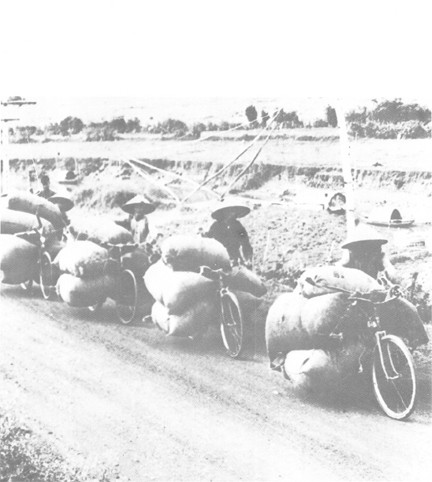
cargo compared to 81,500 tons in May.
Ten Soviet cargo ships and two tankers arrived in June. There were six and three, respectively, in May. The Soviet tanker LENINGRAD was scheduled to arrive at Haiphong in late June but was diverted to Shanghai, apparently because of problems in moving POL beyond the port storage area. There were five free world arrivals during June, one less than in May, and the smallest number ever for one month. One was British and owned by a Hong Kong-based company; two were Cypriot; and there was one each of Maltese and Greek registry. Chinese Communist arrivals increased by two over May, while East European callers dropped by a like number.
Meanwhile, Hanoi continued to build up the momentum of its propaganda, threatening to try U.S. pilots captured in North Vietnam. In the early part of June, the North Vietnamese began depicting an increased popular demand for such action. However, a recently captured document dealing with the treatment of downed airmen forbade rescuing units to harm pilots, even if fellow crewmen were killed, under threat of one to three years imprisonment.
On the political front, North Vietnam took the initiative in improving its relations with Communist China -- as evidenced by the language used in international press releases and the recent North Vietnamese cultural delegation which traveled to Communist China. In addition, there was a growing belief that Ho Chi MINH himself had paid a visit there recently.
China's Foreign Minister Chen YI, meanwhile, as if to show that the power struggle had not altered Peking's policy on Vietnam, made another strongly worded policy statement on 9 June. CHEN told diplomats in Peking that there are two principal preconditions for ending the war: immediate U.S. withdrawal from Vietnam, and U.S. recognition of the Liberation Front as the sole legal representative of the Vietnamese people.
Meanwhile in Cambodia, there were indications that developments in South Vietnam might have prompted Prince SIHANOUK to move closer to a neutral posture. In an address to the officers of the Royal Khmer Military Academy and in private conversations, the Prince said he wanted to improve relations with his neighbors, avoid any arrangement which would draw Cambodia into the "Vietnamese civil war," expand the ICC posts along the Vietnamese border, and sign a joint agreement with Thailand to reduce tension along their common border. Such measures, designed to insure Cambodian neutrality, may reflect SIHANOUK's latest appraisal of the power struggle in Southeast Asia as well as his growing fear that the war in South Vietnam could spillover into his own country -- a situation that Cambodia has neither the economic nor military power to prevent.
Military Civic Action and Psychological Operations
During June, six PsyOps trained officers took on duties as PsyOps officers for MARKET TIME and GAME WARDEN units in the four Coastal Zones and the two Riverine Areas. With the growth of the U.S. Navy commitment, U.S. personnel became more involved in PsyOps and Civic Action programs, encouraging the Vietnamese to do the same.
One example of the effect of U.S. involvement came from PCF Division 104 at Cam Ranh Bay. On occasions PCF and Support Activity personnel have taken injured fishermen to U.S. medical facilities for treatment, made emergency repairs to junks at sea and sponsored movies for local children -- among other civic action projects. The effectiveness of the program was emphasized when the Division Commander was invited to dinner by the Village Chief of Binh Ba. The Chief said that when the PCFs first came, the people were worried about being mistreated, but that now they were more secure than ever before. The Chief said also that his people appreciated the thoughtfulness of the searchers and were particularly nappy to be allowed to fish in the patrol area. This special consideration resulted in the best catch of fish for his village in many years.
In the Second Coastal Zone an initial experiment using portable loudspeakers aboard a PCF was conducted in the area north of Nha Trang. Chieu Hoi broadcasts using tapes prepared by Second Coastal Zone PsyOps personnel were conducted for a period of ten hours with encouraging results. In one instance a group of fishermen put to sea from their village and reported that the Viet Cong, who had been in the village, had departed. In a second instance, a group of fishermen applauded when they heard the tape and asked to have it played again.
A unique Medical Civic Action Program (MEDCAP) was established in the Third Coastal Zone. Volunteer doctors and nurses of the U.S. Army 36th Evacuation Hospital at Vung Tau and VNN personnel and advisors of Coastal Groups 32 and 33 on their days off, have boarded Coastal Group junks and traveled to coastal areas north of Vung Tau and to villages in the Rung Sat Special Zone to treat the villagers. This MEDCAP action has been highly successful.
In the Fourth Coastal Zone a ten family housing unit was complcted during the month for Vietnamese Navy dependents at An Thoi. This is the third such unit constructed in a program to replace those destroyed by fire on 30 April 1966.
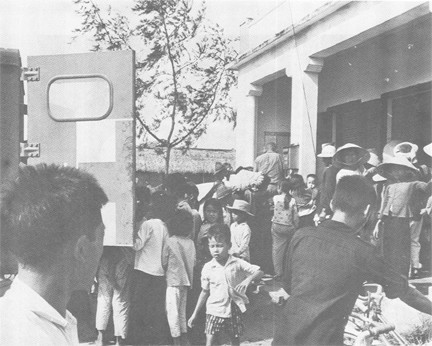
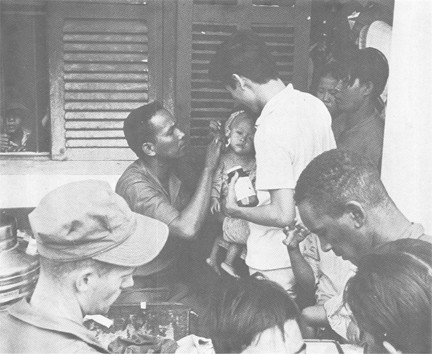
Civic Action Summary:
1. Construction projects completed were all repairs or renovations and were joint projects with RVNAF.
| a. | Bridges | 1 |
| b. | Hospitals | 1 |
| c. | Market places | 1 |
| d. | Schools | 1 |
2. Medical treatments:
| a. | General medical | 13,155 |
| b. | Dental | 753 |
| c. | Surgery | 138 |
| d. | Hairlip operations | 6 |
Comment: The bulk of the medical and all dental work reported was accomplished aboard the Vietnamese Navy Hospital Ship (LSMH 400) during its deployment in IV Corps area.
3. Health and sanitation:
| a. | Physical examinations | 64 (X-rays) |
Comment: Conducted aboard LSMH 400.
4. Distribution of commodities (pounds unless otherwise specified).
| a. | Cement |
1,200 |
| b. | Clothing |
13,945 |
| c. | Children's Vitamins (Bottles) |
328 |
| d. | Family kits |
60 |
| e. | Food |
115,550 |
| f. | Lumber (board feet) |
768 |
| g. | Medical, non-prescription |
628 |
| h. | Soap |
880 |
| i. | Tin sheets |
50 |
| j. | Textile kits |
885 |
| k. | Wash bucket kits |
985 |
5. Educational efforts:
| a. | English classes: | 4; attendance, 110. |
| b. | Carpentry classes: | 1; attendance, 44 |
6. Voluntary contributions in support of: (in piasters)
| a. | Orphanages | 5,900$VN |
| b. | Schools | 13,640$VN |
| c. | Religious | 12,000$VN |
| d. | Hairlip and miscellaneous operations | 3,363$VN |
7. Efforts not otherwise mentioned above:
| a. | |
| b. | |
| c. | |
| d. | |
| e. | VNN advisors arranged for delivery of 80,000 magazines within VNN area of responsibility. |
Progress in the I Corps was more evident in June than at any time since the arrival of the Marines in Vietnam. The people were more free of the Viet Cong; Government administration of hamlets was expanding; people could travel more; and there was increasing intelligence from the people. For the fourth consecutive month, there were over 10,000 small unit operations. Of more than 1200 confirmed kills, almost one third were in the small unit engagements. Companion to this were 11 large-scale Marine offensive operations -- nine by III MAF and two by Marines of the Special Landing Force (SLF) of the SEVENTH Fleet. Marine aviators flew more than 3,000 fixed wing attack sorties in June which was about 150 fewer than in May. Their armed helicopter sorties, however, totalled more than 38,000
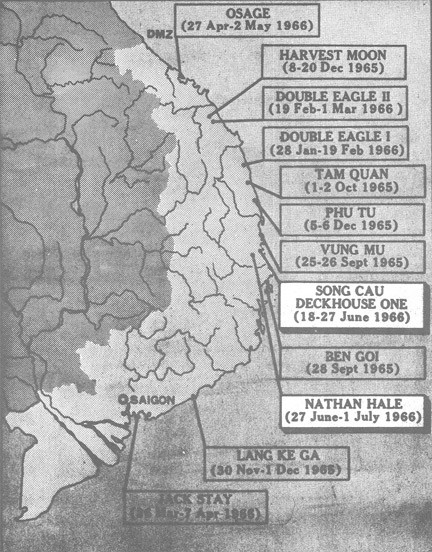
which was an increase of about 1500 over the May figure. There were seven County Fair type operations in which 2600 villagers were screened, fingerprinted and interviewed. Even though these villages had been previously cleared, these careful searches netted two VC killed, 16 captured, including one guerrilla platoon leader, and 15 suspects apprehended.
Perhaps as significant as any other program was the road building by the Marines. Since April, 46 kilometers of roads have been opened up where surface travel had previously been impracticable.
Since the fall of 1965, Marines of the SLF of the SEVENTH Fleet have participated in 12 large scale operations, including DECKHOUSE ONE and NATHAN HALE in June. The conclusion drawn by FMFPAC in his Operations of U.S. Marine Forces Vietnam of June 1966, is that the free world "is winning in I Corps, not just militarily, but in all the convergent battles which go to make up the war." If it is illustrated in no other way, he says, it is made clear "by the enemy inability... under ideal conditions of political unrest ... to do little more than infiltrate urban mobs and accelerate their... terrorism."
All of the ingredients of success for the Viet Cong were there, he says; yet nothing happened. Then to his own rhetorical question of why, he answers that they were simply unable to take advantage of their own favorable situation.
FROM VA 56 ABOARD TICONDEROGA (14 A4Es) on A-4 STREAMLINING:
On one strike this squadron launched four A-4Es with no external tanks. The bomb load consisted of one MK 84, two MK 83, and two MK 82s. Distance to the target and return was approximately 400 miles. Each aircraft refueled from wet wing tankers, taking on an average of 1600 Ibs of fuel per aircraft. In this manner ordnance delivered on target was maximized while aircraft exposure to hostile fire was minimized due to higher airspeeds. Additionally, it was found that enroute to the target the formation was more maneuverable than on previous large strikes. The reduced drag of the clean aircraft partially offset the reduced fuel load. Although one aircraft was forced to abort prior to reaching the target due to mechanical difficulty, the remaining three aircraft were able to deliver in excess of 15 thousand pounds of ordnance.
FROM ATTACK AIRWING 5 ABOARD TICONDEROGA ON MINIMUM ALTITUDE IN NORTH VIETNAM:
A minimum ceiling of 3,000 feet is normally established in NVN. This altitude, however, should be considered the minimum pullout altitude. Therefore, a greater ceiling than 3,000 feet is required to maneuver the aircraft to establish a dive angle.
FROM USS DALE (DLG 19) ON PHANTOM TARGETS:
Ships continue to report flights of birds, schools of fish and other phantom targets as actual surface units. Contacts give small but solid returns, and have been tracked on varying courses at maximum speeds of 16 to 35 knots. Fire control radars have been able to lock on these targets and track them within 3,000 yards. From radar information only, these targets could easily be evaluated as PT boats. Evaluating these targets with passive sonar, however, has revealed screw noises to be non-existent. Therefore, the radar-return could not be from a surface contact.
FROM USS ENTERPRISE ON HARASSMENT:
Trawler maneuvers appeared to be directed toward closing ENTERPRISE for observati.on rather than harassment. At no time did a trawler place itself in a dangerous situation while maneuvering near ENTERPRISE. However, an escort while attempting to block for the carrier may find itself maneuvered into an embarrassing position with the carrier. As a result, the blocker rather than the trawler becomes the real danger. Utmost caution, therefore, must be exercised by the escort to avoid placing itself in a burdened position with respect to the Task Unit that it is screening.
FROM USS KITTY HAWK ON THE A-6A:
The A-6A proved to be a formidable weapon in all weather and in daylight strikes. Its ordnance capacity is four to six times that of the smaller A-4 and greater than anything else the Navy has used in Southeast Asia. Standard bomb loads were 13 x MK 83 or 5 x MK 84.
It was also extremely effective in night all-weather attacks against such radar significant targets as the Thanh Hoa Bridge and the Uong Bi Thermal Power Plant.
FROM ATTACK CARRIER AIRWING 11 ABOARD KITTY HAWK ON SOME "DOs AND DON'Ts":
1. Never fly over land without an escort. (A-6 in inclement weather or at night is the exception.)
2. Never make a second pass in the same target area.
3. No not fly directly over river mouths and coastal islands when coasting in or exiting.
4. When possible, plan to fly across rather than parallel to roads, railways and rivers.
5. Never end a route segment at a highly defended area. Cross major threat areas early, because of the enemy's advance warning capability and his excellent communications system.
6. Break up long route segments into short segments and schedule them on alternate flights.
7. A low and extended over water approach to a pop-up at the beach line does provide a surprise element for crossing coastal defenses.
8. Do not become stereotyped in runs. For example, avoid making all runs toward the water and don't turn left every time. Fly a random flight path.
9. Avoid flying directly under or immediately over an overcast layer.
EXPENDITURESOF GUN AMMUNITIONFOR FIRE SUPPORT IN SEASIA
| MONTH | DAYS |
CALIBER | ROUNDS | AVG ROUNDS PER DAY |
| MAY 1965 |
11 |
All 5"/54 5"/38 |
345 60 285 |
31 |
| JUN |
30 |
All 8"/55 6"/47 5"/38 3"/50 |
2910 163 123 2430 194 |
97 |
| JUL |
31 |
All 6"/47 5"/38 3"/50 |
7981 147 7521 313 |
257 |
AUG |
31 |
All 6"/47 5"/54 5"/38 3"/50 |
13670 1481 242 11706 241 |
440 |
SEP |
30 |
All 6"/47 5"/54 5"/38 3"/50 |
17390 550 795 16012 33 |
579 |
OCT |
31 |
All 6"/47 5"/54 5"/38 3"/50 |
21964 126 1333 20470 35 |
708 |
NOV |
30 |
All 6"/47 5"/54 5"/38 3"/50 |
12780 93 277 12222 188 |
426 |
| DEC |
31 |
All 5"/54 5"/38 3"/50 81 MM |
11291 1856 7291 1050 1094 |
364 |
| JAN 1966 |
31 |
All 6"/47 5"/54 5"/38 3"/50 81 MM |
13688 104 1015 12093 348 128 |
441 |
| FEB |
28 |
All 6"/47 5"/54 5"/38 3"/50 81 MM |
19556 1810 840 16428 68 410 |
698 |
| MAR |
31 |
All 8"/55 6"/47 5"/54 5"/38 3"/50 81 MM |
15964 491 655 3796 10586 237 199 |
514 |
| APR |
30 |
All 8"/55 6"/47 5"/54 6049 5"/38 5" SSR 3"/50 81 MM |
30040 404 321 16735 3679 1954 898 |
1001 |
| MAY |
31 |
All 8"/55 6"/47 5"/54 5"/38 5" SSR 3"/50 81 MM |
30161 285 131 2949 13405 12062 690 639 |
972 |
| JUNE |
30 |
All 8"/55 6"/47 6 5"/54 5"/38 5" SSR 3"/50 81 MM |
32877 1063 3597 16848 9011 1116 1236 |
1095 |
Total |
2,230,617 | |||
Types of ships that have conducted missions: CAG, CLG, DD, DDG, DE, DER, DLG, AV, APD, WPB, IFS, LSMR. General Purpose Destroyer type ships assigned majority of missions.
| CONCEPT |
- NGFS in VIETNAM supports: |
|
| TARGETS |
- Infiltration points - Equipment - Staging Areas - Troop Concentrations |
Arms Caches Training Areas Food LOC |
EFFORT |
- 21 May 1965 through 30 June 1966 |
|
| FORCES |
- Adequate for present requirements |
|
MATERIAL SALVAGED FROM POINT LEAGUE TRAWLER
Approximately 80-100 tons of ammo, weapons and other items of intelligence interests were removed by USN/VNN units, including:
Weapons
7 |
82mm Mortars |
316 |
7.62mm Automatic Rifles |
100 |
7.62mm Side Arms |
| 605 | 7.62mm Semi-Automatic Rifles |
| 21 | 7.62mm Light Machine Gun (Type 56) |
| 60 | BAR Type 7.62mm Weapons |
| 20 | 75mm Recoilless Rifles |
| 25 | 40mm Rocket Launchers |
Ammunition
1,851 |
82mm Mortar Rounds |
222,880 |
7.62mm Rounds |
1,500 |
40mm Rockets |
| 760 | 75mm Recoilless Rifle Rounds |
| 122,000 | 12.7mm API Rounds |
| 2,000 | 40mm HEAT Rounds |
| 100 | Fragmentation Grenades, Pull Friction |
Miscellaneous
9 |
82mm Mortar Bi-Pod Assembly |
7 |
82mm Mortar Base Plates |
13 |
82mm Mortar Battery Powered Range Sight with Carrying Cases |
| 18 | 82mm Mortar Sighting Stakes (Sets) |
| 91 | Light Machine Gun Drum Type Magazines with Links |
| 10 | 7.62mm Anti-Aircraft Machine Gun Carriages |
| 18 | 75mm Recoilless Rifle Base Rings |
| 1 | 75mm Recoilless Rifle Tool Kit |
| 12 | 12.7mm Heavy Machine Gun Barrels |
| 12 | 12.7mm Heavy Machine Gun Receiver Groups |
| 18 (pr) | 12.7mm Heavy Machine Gun Carriage Wheels with Axles |
| 2 | 12.7mm Heavy Machine Gun Tri-Pods |
| 58 | 12.7mm Ammunition Cans with Links |
| 3 | 12.7mm Heavy Machine Gun Anti-Aircraft Sights |
| 33 | 200 Gram TNT Blocks |
| 20 | Unidentified Small Caliber Ammunition Cans with Links |
| 3 | Battery Powered 57mm Recoilless R ifle Sight Sets |
MARKET TIME STATISTICAL SUMMARY, JUNE 1966
1. Average number of U.S. ships/craft on patrol during the month:
| DER | MSO | MSC |
WPB |
PCF |
|
| TOTAL | 150 | 165 |
75 |
501 |
751 |
| DAILY AVG | 5 | 6 |
3 |
17 |
25 |
2. Average number of VNN ships/junks on patrol during the month:
| SEA FORCE | RIVER FORCE |
COASTAL FORCE |
|||
| TOTAL | 510 | 3044 |
4642 |
||
| DAILY AVG | 17 | 101 |
155 |
||
3. U.S. Activity:
TOTAL DETECTED |
WOOD - STEEL - |
DAY |
45,803 |
NIGHT |
59,105 |
TOTAL INSPECTED |
WOOD - STEEL - |
DAY |
12,439 |
NIGHT |
14,211 |
TOTAL BOARDED |
WOOD - STEEL - |
DAY |
15,085 |
NIGHT |
8,888 |
4. VNN Activity:
| SEARCHED: | 23,005 |
| DETAINED: | 30 |
5. Remarks:
| Junks detained by U.S: | 145 |
| Persons detained by U.S: | 1,481 |
| Persons detained by VNN: | 797 |
GAME WARDEN STATISTICAL SUMMARY, JUNE 1966
| Junks Detected: | 9,418 |
| Junks Boarded: | 3,127 -- compared with 5,722 in May |
| Junks Inspected: | 4,658 -- compared with 366 in May |
| Junks Detained: | 14 -- compared with 26 in May |
| Persons Detained: | 153 -- compared with 159 in May |
| VC KIA: | 21 |
| VC WIA: | 2 |
| VC POSS KIA: | 15 |
| US KIA: | 0 |
| US WIA: | 2 |
| PBR PATROL DAYS FOR MONTH: | 1,586 |
| PBR PATROL DAYS UTILIZED: | 1,150 |
| USAGE: | 72+% |
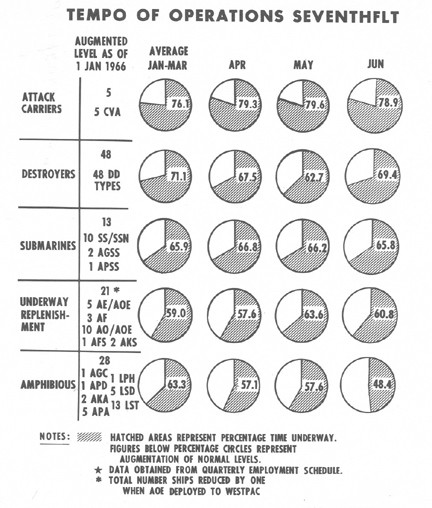
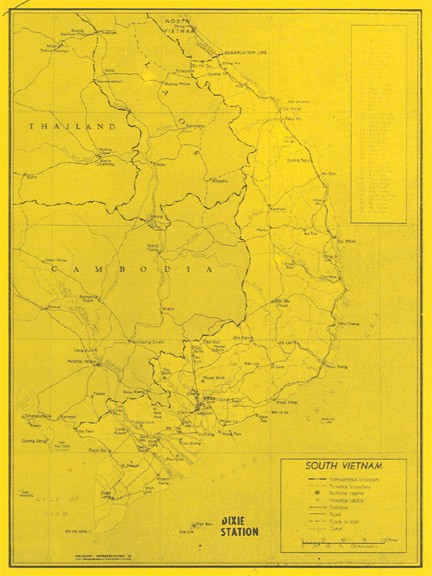
This document is part of the Vietnam Command Files, Operational Archives Branch, Naval Historical Center, Washington, D.C.


